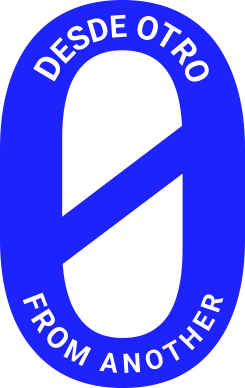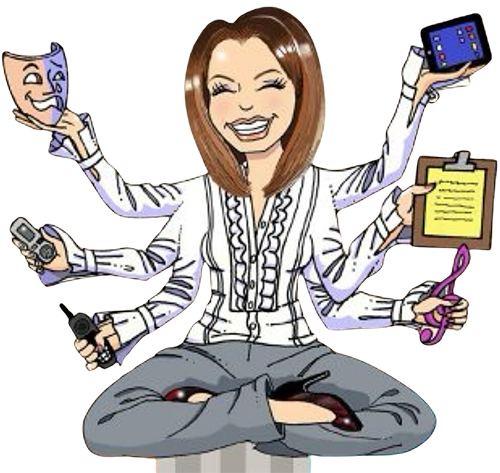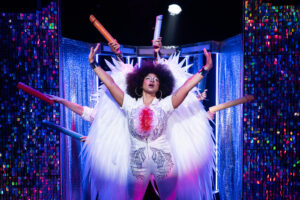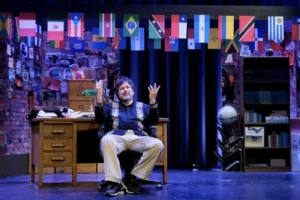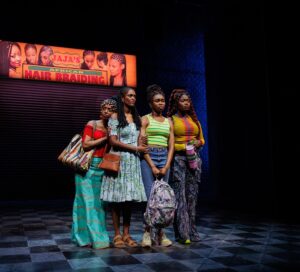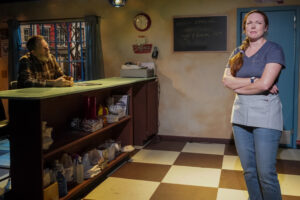 |
| Having the option of seeing a show trough the monitor |
come about and how long did it take them to make a program out of it?…
“It started a couple of
years ago, my position is Guest Services Coordinator, so I work with our
accessibility services at the center and a couple of years ago, I went to a
conference in Chicago called The
Leadership in Arts and Disability, where a lot of museums and arts
organizations get together and talk about how to make basically, your venue
more accessible to the public. And one of the topics that year, was to offer
sensory friendly programming to people with Autism Spectrum and
other developmental disabilities”.
is not the type of programming that you could put together very
quickly, it is a process that you have to organize an internal committee
to figure out next steps in order to make this a reality. Then, we had
an external committee with organizations in the area to really get their
feedback on this demographic. We did not really have a lot of firsthand
knowledge about their expectations when coming to a show, or maybe
their anxiety, so maybe we know exactly what to expect for that. We also
had a consultant from Pennsylvania, an occupational therapist who works
at Temple University and he has a ton of experience with organizations that have done sensory friendly programming before, like The Kennedy Center. We
brought him here and he interviewed families and helped us create some
marketing and internal education on what these types of programs are, and
how it relates to the community out here. Last Halloween we had our
first performance called Room on the Broom
a lot of preparation went into that. Educating front of house and our
box office staff so they would know how to deal when selling tickets on
the phone for sensory family shows.The response has been very positive”.
- Reduction
of sound levels, particularly loud or startling sounds.
- Reduction
of overwhelming stage lighting.
- Low
ambient lighting in the theater throughout the performance so patrons are able
to see should they need to move around or exit the theater.
- Preparatory
materials called Previsit Guides will be provided to patrons so they will know
what to expect from the performance. Previsit Guides include pictures with
simple captions of the theater going experience.
- The use of
iPads or smart phones are allowed during the performance if they are being used
as a communication device.
- Designated
break spaces will be available for those who might feel overwhelmed and need a
break from the performance.
Sensory Friendly Performance Break Area
 |
| Sensory Friendly Performance Break Area. |
There are preview show guides that walk you trough the process of a Sensory Friendly show at the SCFTA.
most misunderstood character in fairy-tale history. Put simply, he has no
friends –just incredibly sharp teeth, yellow eyes and his own ideas about
personal hygiene. Luckily, Heidi Hood, Little Red’s second cousin twice
removed, is brave enough to see past this wolf’s bad press, and an unlikely
friendship is born. This hilarious, table-turning tale that features puppetry,
a poetry competition and plenty of dancing will have you wondering why you were
so scared of the wolf in the first place.
Bad Wolf
Center for the Arts – Samueli Theater. 615 Town Center Drive, Costa
Mesa, CA
March 5 will be sensory-friendly. The 1 p.m. performance on Sunday, March 6
will be ASL interpreted.
the medium of physical theatre, illusion and music. It is a sad, funny and
delightful tale that explores the theme of leaving the nest, a theme that
resonates as strongly with the adults as it does with children. This gives Egg
its real emotional power. The production is a magical experience, sharing the
life of the little bird characters in their nest with the audience and telling
a story of friendship, wonder and tender loving care.
Segerstrom
Center for the Arts – Samueli Theater. 615 Town Center Drive, Costa
Mesa, CA
2016 at 10 a.m. and 1 p.m.
at 1 p.m. and 3:30 p.m.
Tickets – $20
on Saturday, March 19 will be sensory-friendly.
